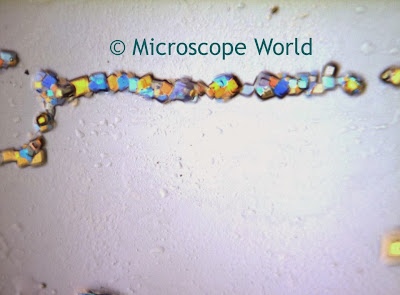Polarizing microscopes are used to look at thin sections of rocks and minerals. It is very important when using a polarizing microscope that the thickness of the sample is correct in order for the light to shine through the specimen properly and produce a high quality image. Polarization requires accurate measurements involving light intensity, patterns and colors and therefore specimen thickness is probably the most important factor when preparing samples.
Adequate transparency for identification of minerals requires a section that is 0.02mm - 0.03mm thick. For materials where only structure is of interest, sections may be as thick as 0.25mm or more.
Both grains and thin sections are examined under a polarizing microscope and it is frequently important to know the refractive index of the mounting medium. In the majority of cases with grains, it is more efficient to mount grains with oils. Temperature effects on refractive index determinations are great and any exact statement regarding refractive index must include the temperature at which it was determined. If temperature changes are accompanied by changes in chemical composition, optical properties may change as well.
Platy minerals such as mica or other minerals in grain form are more difficult to manipulate under a cover slip and will not roll over well. It can be helpful to mix a little powdered glass with the mineral or grains in order to separate the cover slip and the sample and allow the platy material to move and turn over freely.
Adequate transparency for identification of minerals requires a section that is 0.02mm - 0.03mm thick. For materials where only structure is of interest, sections may be as thick as 0.25mm or more.
Both grains and thin sections are examined under a polarizing microscope and it is frequently important to know the refractive index of the mounting medium. In the majority of cases with grains, it is more efficient to mount grains with oils. Temperature effects on refractive index determinations are great and any exact statement regarding refractive index must include the temperature at which it was determined. If temperature changes are accompanied by changes in chemical composition, optical properties may change as well.
Platy minerals such as mica or other minerals in grain form are more difficult to manipulate under a cover slip and will not roll over well. It can be helpful to mix a little powdered glass with the mineral or grains in order to separate the cover slip and the sample and allow the platy material to move and turn over freely.
 |
| Litric Acid captured at 400x under the MT9300 Polarizing Microscope |